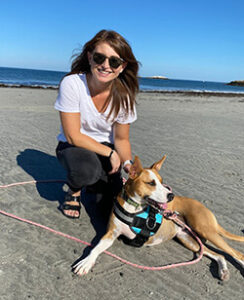
Julia Mancuso, MSN, CRNA, was out having lunch with her mom the Saturday after Thanksgiving in 2018 when her entire world changed. 
“We had just received our meals. The last thing I remember is taking a bite of a French fry, then I just completely lost consciousness,” said Mancuso, a Certified Registered Nurse Anesthetist (CRNA) practicing south of Boston.
Her mother, who has a background as a neurology nurse practitioner, pulled Mancuso out of her chair and got her down on the ground to lay her on her side. “She was worried that I was having a seizure just based on my lack of responsiveness. There were two women sitting at the table next to us, both nurses, and they helped my mom get me to the ground. It wasn’t clear to anyone what was happening to me.”
Mancuso was taken by ambulance to a local hospital. After several hours passed without a brain scan, her stepfather, a neurologist at Brigham and Women’s Hospital (BWH) in Boston, came to the hospital and did a quick assessment of her. He urged the emergency room staff to scan her brain.
Mancuso had a massive hemorrhage in her brain. She was immediately taken by ambulance to BWH for further treatment.
“It was very dangerous to be transferring me with such a significant brain bleed because I could stop breathing at any time, but it was the only foreseeable option to save my life,” Mancuso said. “I could die at any moment.”
Doctors at BWH determined the otherwise healthy 30-year-old experienced a ruptured cerebral aneurysm.
She was intubated and sedated overnight. Dr. Rose Du, a cerebrovascular neurosurgeon, performed an emergency craniotomy to clip the aneurysm first thing the next morning.
“The initial focus was in making sure that the aneurysm was clipped so it couldn’t continue bleeding,” Mancuso said, “following a subarachnoid hemorrhage, the concern then shifts to that of resulting arterial vasospasms throughout your body, but especially in your brain. And when your vessels spasm, they’re not able to effectively pass blood flow through them, which leads to ischemia. In other words, the cerebral vasospasm that occurs as a result of the brain bleed, causes strokes.”
Mancuso suffered a number of strokes after the initial insult, which further complicated her recovery from the aneurysm. She spent a month in the Neuroscience Intensive Care Unit at BWH, celebrating her 31st birthday during the stay. Through it all, her family was by her side.
“My family and friends have been amazing. They’ve been there in ways that I never would have ever expected,” she said.
Her dad loved bringing in her favorite foods to nourish and support her healing. Her sister visited every morning to braid the remaining hair on her head from where it had been shaved for the drains and craniotomy. Her brother helped keep her calm and grounded. And, most importantly, her mom and stepdad saved her life thanks to their quick action and expertise.
In addition to the team at BWH and her friends and family, she credits the support of her CRNA colleagues with helping her get through the most challenging experience of her life. They planned and organized a fundraising event in her honor at a local country club following her discharge from the hospital. Over 300 people were in attendance.
“It was truly incredible. The outpouring of love and support that I received was genuinely beyond anything I could imagine,” she said.
Against all odds, she was back at work with her colleagues less than two months after being discharged from the hospital. She partly credits her recovery to being a young person who was healthy and active prior to the ruptured aneurysm, but even her doctors can’t explain how quickly she bounced back.
“I feel – and I’ve been told so many times by my neurosurgeon, Dr. Du, and my neurologist, Dr. Pilgrim – that my recovery is truly miraculous,” she said.
Mancuso said while she was grateful to come back to work part-time so soon after being discharged, the experience was challenging. Three years later, her resilience during her recovery shines through. Mancuso continues to deal with fatigue and headaches, which are very common in individuals recovering from traumatic brain injury. She credits her ongoing healing to her long-held holistic health philosophy, with the focus of supporting her body and mind every day.
“As much as you’d like it to, life doesn’t go back to ‘normal’ after something like this,” she said. “I’m very accepting of what happened, and I’m grateful for where I am. The experience changed me so drastically – how could it not, being on the brink of death more than once over the course of a single month?”
She expressed sincere gratitude for all of the nurses, doctors and ancillary staff at BWH’s Neuroscience ICU. She also finds immense joy in her work as a CRNA, spending time with family, friends, her supportive partner and her three-legged rescue dog, Luna.